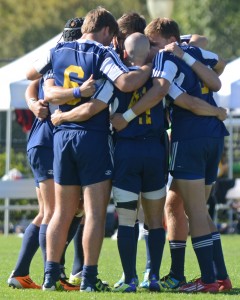In recent years, rugby has gotten more popular in the United States.
Its presence in high schools and at the college level is growing now that the Olympics will feature seven-a-side rugby in 2016.
But varsity rugby teams at colleges are rare, and many still compete at the club level.
The difference between varsity and club rugby is, at its simplest, one of funding. Varsity rugby is a school-funded sport, run through the university’s athletics program. Club and varsity teams still play one another, but the club teams are responsible for all their own fundraising, from buying equipment to paying for travel.
UCLA’s men’s rugby team, which will compete at the Collegiate Rugby Championship this weekend, is a club team.

According to the team’s website, UCLA rugby was varsity up until 1982, when Title IX restrictions made it impossible for the school to keep it on. Title IX is a piece of federal legislation that expanded women’s opportunities in many areas, including college sports. Funding and participation has to be balanced for both men and women in college athletics programs.
Since men’s programs such as football require far more funding and manpower, it is difficult to add additional men’s sports without at least one women’s counterpart.
There are many issues that go along with being a club sport – a big one is recruiting.
Club teams cannot recruit players to come to a school specifically to play the sport.
This means UCLA rugby has had to find a way to draw players with no guarantees and no money available; however, once potential players do get into UCLA, coach Scott Stewart said, the academic as well as athletic opportunities available often make the school a great pick for them.
One of UCLA’s main competitors is California, which has had a varsity team since 1882. It is one of the few teams that remained at a varsity level through Title IX legislation – the majority of the nation’s top varsity teams moved up from club status in the last 13 years. Cal has been a steadily dominant presence on the West Coast rugby scene and presents a major challenge for UCLA.
“Cal is a varsity program and we compete against that, and it’s difficult. But we still think it’s important for us to be playing them because they’re traditionally one of the best teams in the country,” Stewart said.
The fact that most of the varsity teams gained that status in the 20th century coincides with the expansion of rugby in the United States. According to Stewart, rugby has grown in popularity at the younger levels, with high school students getting involved with and gaining interest in the sport, creating a stream of players for colleges.
While being a club sport can be a struggle when it faces varsity teams such as California’s, Stewart did say that the hard work that his team has to put into every aspect of its game, from fundraising to recruiting players, makes it a stronger, better team.
“I think it builds character for us. … What is under our control is being the best team we can be, working as hard as we can and trying to adhere to a plan that allows us to do that,” Stewart said.
Rugby is not run through the NCAA but rather through USA Rugby, an organization that organizes competition throughout the country at the club, college and youth levels.
Additionally, the sport’s structure has begun to take on some aspects of NCAA structure. For example, the traditional Pac-12 teams organized themselves this season into PAC, which is a conference created so that they can play their traditional rivals. As non-NCAA teams, they cannot use the title Pac-12, but the PAC still has a page on the Pac-12 website.
“We’ve felt that it made a lot of sense for the participating teams in PAC … to play against our traditional rivals because there’s a lot of value not only in those fixtures, but the value those students bring back to their own campuses when competing against familiar teams,” Stewart said.
Rich Cortez, director of collegiate rugby with USA Rugby, noted the importance of these structures in the rise of rugby’s prominence.
“The schools that are doing it right, like the PAC, they’re all trying to take it out of the intramural type arena and into a more serious one. … The rules have been modified to adequately reflect NCAA-type rules,” Cortez said.
While men’s rugby struggles to reach varsity status due in part to Title IX restrictions, there has been a recent advent in thought that men’s and women’s programs can pair up to try to get both of their teams to the varsity level, especially now, when both men’s and women’s rugby have been taken on at the Olympics level.
“It’s definitely growing in both genders. There’s an opportunity to work together, there’s an opportunity to present things together with the Olympic ideal in mind,” Stewart said. “There is some benefit to researching and coming up with an action plan on our end, anyway.”
Cortez also noted the importance of men’s and women’s rugby rising to prominence together, saying that a “unified program could help them realize synergy,” and noting positive funding implications in one unified program, as donors would be excited to give to both teams.
Tam Breckenridge, a former assistant athletic director for UCLA and a current associate collegiate director for USA Rugby, noted that men’s and women’s teams have been working together more in recent years. She said that barriers between the genders in sports have broken down, and it has shown in rugby.
She acknowledged that Title IX does make it difficult for men’s teams to go varsity. She did suggest, though, that men could benefit from helping women go varsity anyway, as they would receive benefits in access to equipment and better facilities.
“The men may not go varsity, but they gain benefits if women go varsity – they get better equipment and facilities. … It may not be varsity but they will get benefits,” Breckenridge said. “You’d have what you needed for everything but travel, and there’s a lot of fundraising you can do for that.”
However, this does not make a dent in two of the biggest problems for rugby when it comes to club status – recruiting and training.
Rugby is an intensely physical sport, and it is difficult to get players the physical care that they need at times when they are on a club team, which Cortez said is one good reason for it to move up to the varsity level.
“It’s a unique sport. And it really doesn’t belong in club because of the intense physical requirements and training that you need. … There are safety issues which can only be handled by proper training and rehab,” Cortez said of both men’s and women’s rugby programs.
While he was not speaking specifically about UCLA, Cortez said that athletic directors should seriously consider adding rugby to their slate of varsity sports. He said that students are interested in rugby for a variety of factors, such as the excitement of the sport and its international draw, and that athletic directors should pay attention to the sports that students are interested in.

“In these economic times it’s a difficult proposition. Most athletic directors might want to drop something rather than add and that’s a tough deal. But I’m hopeful we can reach a stage where conferences are operating so well that (adding rugby is) an opportunity, rather than this lobbying effort,” Cortez said.
But for now, UCLA rugby continues to compete as a club team and will do so this weekend at nationals in Chester, Pa.

